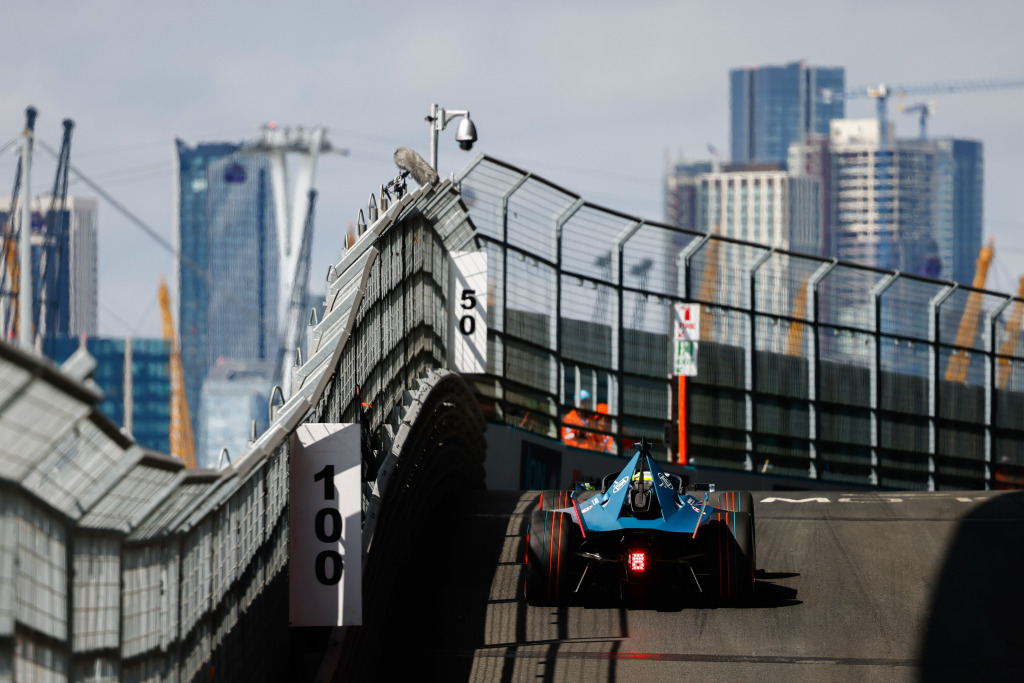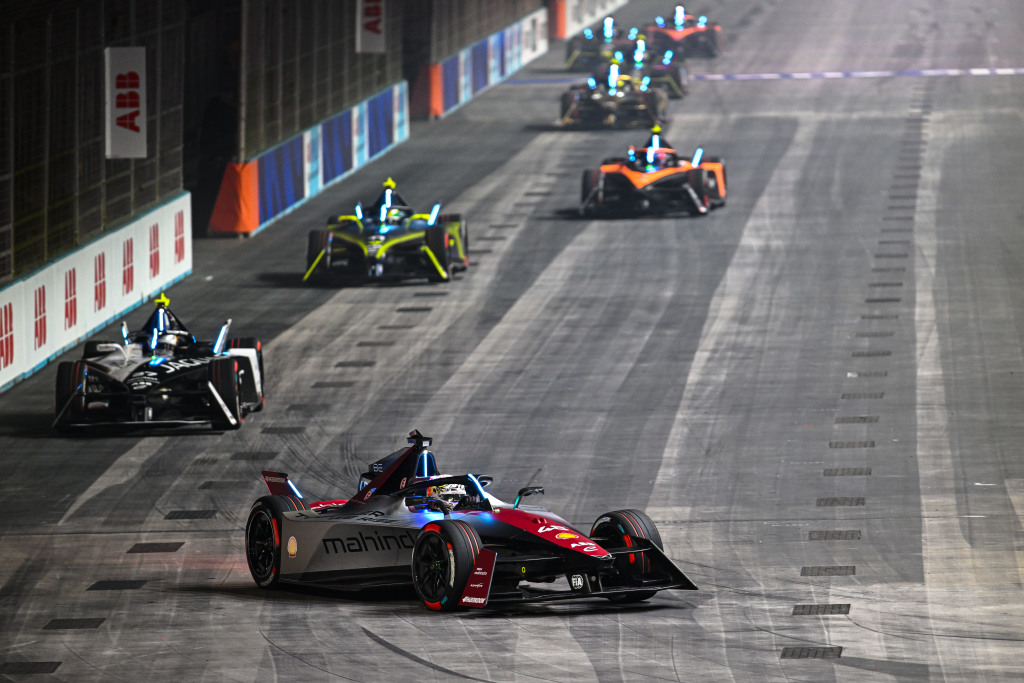Racetracks are outdoors. That’s just how it is. But Formula E doesn’t seem to have got the memo.
Not content with breaking the mold with its cars and its format, the series ran on a unique indoor/outdoor track in London for its season finale last weekend. In fact, it was the fourth time the series has headed to the London ExCeL — a large exhibition space in London’s Docklands — after two events in largely unsuitable Battersea Park, which resulted in much criticism from locals at the time.
But what was the thinking behind putting a racetrack — or at least a sizable chunk of it — indoors? Well, the answer can perhaps be found in those never-ending rumors about a London Grand Prix: Building a temporary circuit on the gridlocked streets of England’s capital is almost impossible, but the ExCeL gives Formula E’s track builders something of a blank slate to play with.
“Trying to find a racetrack in a city, an urban city center, you take whatever land you can get your hands on, right?” Angus Miller, Formula E’s senior track and overlay manager, tells RACER. “And it turns out a massive exhibition hall actually has quite a lot of space available in it. So if we can put a paddock and a racetrack in there, why not?”
 Incorporating an exhibition center into the track adds intriguing elements like elevation changes, while also bringing unique challenges. Andrew Ferraro/Motorsport Images
Incorporating an exhibition center into the track adds intriguing elements like elevation changes, while also bringing unique challenges. Andrew Ferraro/Motorsport Images
Doing so means that Formula E doesn’t have to close any major roads in London, which is obviously a benefit. But while that one major issue goes away, others come up. There might not be traffic, but the ExCeL remains an open, working venue all year round.
“Because it is an exhibition center, they’re booked out. They’ve got things on, so we have to get in, build our track, and get out,” Miller explains. “It takes us about two, two and a half weeks to build the track, and then a week to get out.
“And when you’ve got a lot of stuff on top of each other… we’re trying to use every space we can, so if there’s not a grandstand there, we’ll see if we can squeeze it in. But you’ve got to account for evacuation capacities — how do you move people around? How do you get people into the paddock?”
“It’s a trade-off here. I think it’s easier because we control the whole venue. We don’t have external traffic we have to manage; we don’t have to do traffic closures with the police. But it is a fast build, so we have a lot of people on top of it. I would love it if they would rent us the halls for two months, but I don’t think the finance department would be so keen on that.”
Having a roof over the track also brings up the problems of emissions. Yes, the cars may be electric (and no, they aren’t charged by diesel generators — power for the chargers comes directly from the local grid wherever Formula E races), but there are things like tire smoke and ventilation to consider.
“They’ve got big extractor fans in the halls,” Miller explains. “We have a coordinated effort to turn them up to 100, especially for the start. When you’re doing those burnouts at the start, we just crank the air con. That’s already here, there’s not much more we could do to clear it out much faster. But they do have big ventilation systems that can clear it relatively quickly.”
 Sam Bagnall/Motorsport Images
Sam Bagnall/Motorsport Images
The indoor section, while appearing to be one of a kind, actually draws parallels to the Diriyah E-Prix in Saudi Arabia, which at present is Formula E’s only night-time event. But for all intents and purposes, London’s race is also a pseudo-night race, with the indoor element both appearing as one, and being handled like one, too.
“It is actually some of the same kit,” Miller explains. “It’s the same company that does the lighting, and they set it up exactly as they would for a night race.”
The track surface itself does require some attention. While the outdoor aspect utilizes existing perimeter roads and streets, indoors it’s a polished concrete floor that Formula E has modified slightly.
“We don’t do anything each year, but what we did in Season 7, when we first came here, we ground back the top, 0.7 millimeters of the of the concrete, then filled it with a resin epoxy, which has a lot more grippy aggregate in it,” Miller reveals. “That’s what gives the cars the texture to drive on. If we hadn’t done that, it’s just polished concrete, and that’s just an ice skating rink.
“And that’s still there. It holds up each year. The ExCeL paints on top of it for their events, just to refresh it, (but) we just come in and remove that top layer of paint, and it just goes back to our treatment and it’s ready to go. Once all our stuff goes in, it’s just floor. There’s no step, there’s no level of difference. It’s just regular floor.”
The ExCeL is currently in the middle of a multi-year renovation project that has also caused Formula E some headaches — this year’s track differed from last year’s with major alterations to the outdoor element — but long-term it’ll be a benefit, with the series’ requirements being factored into the build process to future-proof the track and event somewhat.
“The development that the ExCeL has been doing has been in the works for the last two or three years, and because it is a building development, they’ve got to have architects, they’ve got engineers, they’ve got to plan it, they’ve got to build it”, says Miller. “We were involved from the very early stages in saying, ‘Well, how do we keep racing here?’
“So they included the big portal door very early in their development designs to help us, to enable us to keep racing. And each year, as the development has continued to be built, we’ve just have to adapt from what point in construction they’re at.
“Last year, when it was still very much in the ground, they were doing heavy civil works. We just laid our track on temporary asphalt that year so that at the end of the event, they could just keep on building.
“Now that they’re very close to completing it, we are able to get it to the final state — which is their exhibition floor with the same, similar treatment to what we’ve done in the southwest, where they’ve started — with this resin epoxy product, which has like a grip aggregate in it, into their final floor. So once they finish building, they will have built a new exhibition extension that has a racetrack already included. In theory, this will be the same track for next year because it’s been built into those plans.”
The indoor element is very much unique, but that hasn’t stopped the thought of another similar track making its way onto the Formula E schedule at some point.
“It comes up every now and then when we do a feasibility study for a new race,” Miller says. “We keep it in the back of our minds. If the venue suited it absolutely, there’s no real technical reason that’s stopping us now. We learned a lot doing it here. I think we could comfortably do it again.”
 A unique racing surface also requires some unique approaches. Simon Galloway/Motorsport Images
A unique racing surface also requires some unique approaches. Simon Galloway/Motorsport Images
What about going a step further and going entirely indoors?
“It’s just trying to find the best track we can,” Miller says. “Given the space we’ve got, we wouldn’t have been able to keep it all indoors (in London). We wouldn’t get the length we need. The lap time would be 20 seconds (with cars) right behind each other. So you kind of have to use the roads you’ve got outside just to try and find that interesting racetrack.
“You’d need a pretty big exhibition center to pull that off. I mean, objectively, (there’s) no reason why not. If you can make an interesting track design, absolutely, but it needs to be a very big exhibition center.”









